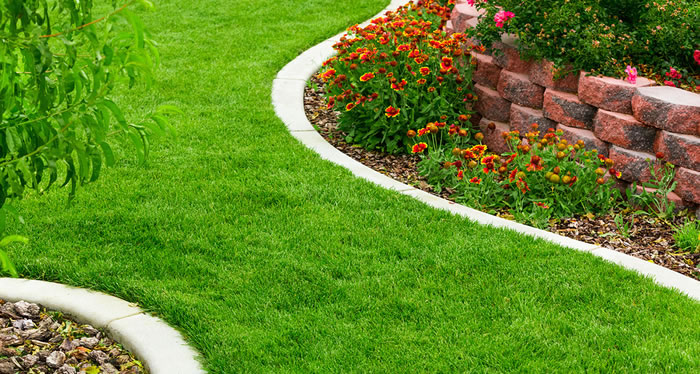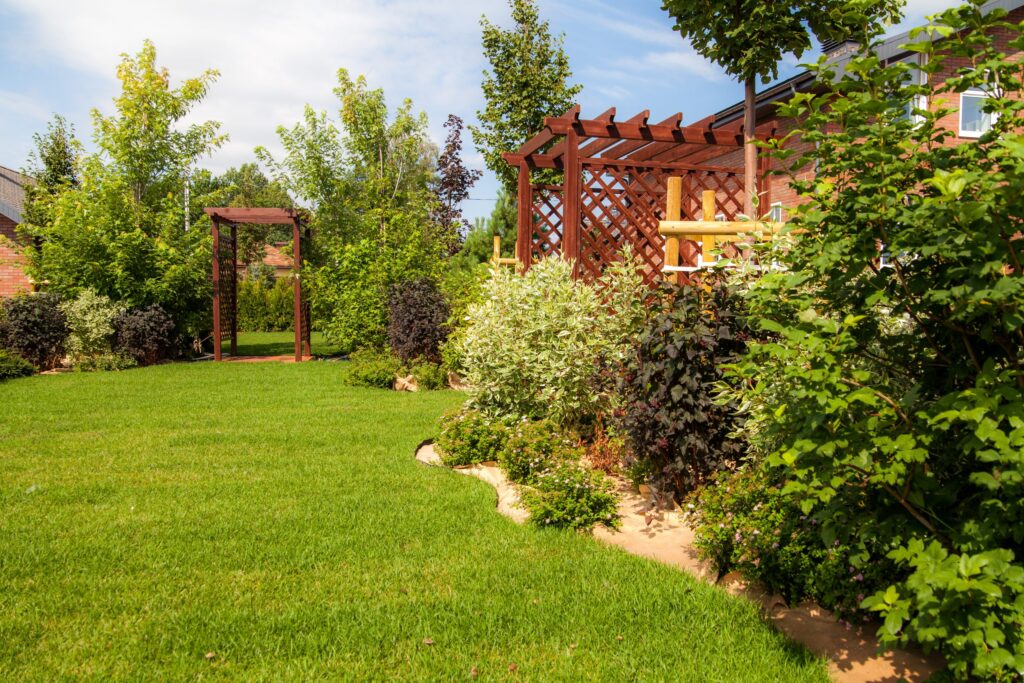Landscaping services vs DIY: What’s right for you
Wiki Article
Understanding the Comprehensive Extent of Works in Specialist Landscaping Services
The considerable scope of professional landscaping services encompasses a range of essential components. It includes landscape design concepts, plant option, and hardscaping functions. In addition, it deals with watering systems and maintenance strategies. Each aspect plays a crucial function in producing useful and aesthetically pleasing outdoor areas. Recognizing how these parts work together can expose much concerning the art and science of landscape design. The journey right into this complex field is just beginning.Landscape Style Concepts
Reliable landscape layout principles are vital for producing harmonious exterior rooms that boost both aesthetic allure and performance. These concepts direct the setup of components within the landscape, making sure a cohesive visual experience. Secret parts include balance, which distributes aesthetic weight equally; proportion, which relates the size of different components to each other and the room; and unity, which produces a feeling of wholeness via consistent styles and materials.
Furthermore, emphasis guides interest to centerpieces, while rhythm establishes movement via repetition of design functions. The effective use line can develop pathways and assist the eye with the landscape. In enhancement, understanding the site's topography, climate, and existing attributes is vital for assimilation with the surrounding setting. By sticking to these fundamental concepts, landscape developers can craft rooms that not just look appealing however additionally serve their designated purpose, boosting the general experience for individuals.
Plant Selection and Installation
In the domain name of professional landscape design, plant selection and installment play an important role in achieving a growing yard - landscaping services. Emphasizing indigenous plant benefits, seasonal considerations, and the particular dirt and sunlight requirements of each types ensures a sustainable and aesthetically pleasing landscape. Cautious planning in these areas not just enhances biodiversity yet additionally advertises lasting eco-friendly wellnessIndigenous Plant Benefits
Why should homeowners consider native plants for their landscape design projects? Indigenous plants use many benefits that enhance both appearances and ecological sustainability. They are well-adapted to regional environments, needing less water and upkeep compared to non-native types. This resilience reduces the need for chemical fertilizers and pesticides, promoting a healthier environment. In addition, indigenous plants provide habitat and food for regional wild animals, including pollinators, which can boost biodiversity in houses. Their knowledge with regional soil and climate condition additionally causes much better development rates and durability. By selecting native plants, home owners not just create aesthetically appealing landscapes but additionally add to environmental conservation, making a favorable influence on their regional setting. As a result, indigenous plants represent a smart option for landscaping tasks.Seasonal Plant Considerations
House owners who have actually welcomed indigenous plants in their landscaping can even more improve their outside spaces by thinking about seasonal plant options. By incorporating plants that thrive in details seasons, they can produce vibrant and aesthetically enticing landscapes throughout the year. Springtime might introduce dynamic flowers like daffodils and tulips, while summertime can display lush vegetation and colorful perennials. Fall introduces a combination of cozy tones with goldenrods and asters, while winter months can be highlighted with evergreens and decorative turfs for appearance. Professional landscaping companies usually suggest selecting plants that not only complement existing indigenous varieties yet additionally provide year-round interest and assistance neighborhood wild animals. This thoughtful strategy to seasonal plant choice assures a continuously developing and lasting yard atmosphere.Soil and Sunlight Needs
Successful landscape design depends upon recognizing the particular soil and sunlight requirements of plants. Various varieties grow under varying conditions, requiring a careful evaluation of both variables throughout the option process (landscaping services). Soil kinds, such as sandy, clay, or fertile, influence drain, nutrition schedule, and root growth. Furthermore, pH degrees can impact plant health, demanding dirt testing to identify suitability. Sunshine needs vary substantially; some plants flourish in full sunlight, while others like full or partial color. An expert landscaper considers these components to guarantee peak development and aesthetic allure. By lining up plant selections with the atmosphere's details features, landscapes can accomplish sustainability, strength, and visual harmony, inevitably causing successful plant establishment and long-term maintenanceHardscaping Features and Construction
While landscaping typically stimulates pictures of rich plant and lively flowers, hardscaping functions play an essential function in specifying exterior areas. These components, which consist of outdoor patios, walkways, keeping walls, and decorative stonework, offer structure and functionality to gardens and lawns. Hardscaping utilizes materials such as concrete, block, wood, and stone, enabling for diverse layouts that enhance the all-natural landscape.The building of hardscaping attributes requires cautious preparation and implementation to assure toughness and visual appeal. Experts evaluate website conditions, water drainage, and spatial connections to produce natural exterior environments. Proper installment methods are important, as they prevent concerns like erosion and moving in time.
Integrating hardscaping not only improves the visual interest of a property but also helps with outside tasks, making it a basic aspect of complete landscaping services. Inevitably, thoughtful hardscaping contributes to both the performance and elegance of outside rooms.
Watering Systems and Water Monitoring
Effective watering systems and water administration are vital parts of specialist landscape design, as they assure that plants receive the necessary hydration for optimal growth. These systems can vary from easy drip irrigation configurations to sophisticated automatic automatic sprinkler, designed to satisfy the details demands of varied landscapes. Proper water management not just enhances water usage, minimizing waste, however additionally enhances plant health and wellness and minimizes condition dangers.Landscaping experts assess various elements, including soil type, plant varieties, and regional environment, to establish customized irrigation services. Furthermore, including rain harvesting strategies can further enhance sustainability and effectiveness (Read More). Regular maintenance of irrigation systems is vital to preserve performance and prevent leakages, which can result in water loss and enhanced expenses. Inevitably, a properly designed watering system plays an essential duty in preserving the aesthetic appeal of outdoor spaces while promoting environmental stewardship within professional landscaping practices
Yard Care and Upkeep Strategies
Yard treatment and upkeep strategies are fundamental for achieving a rich, healthy and balanced backyard that improves the general landscape. These strategies include numerous techniques targeted at promoting optimal growth and visual charm. Regular mowing is necessary, as it motivates thick, even development while protecting against weeds from developing. Additionally, proper fertilizing provides essential nutrients, with applications tailored to the particular turf kind and dirt problems.Watering practices should focus on deep, infrequent watering to motivate root development, while aeration improves soil framework and advertises nutrient absorption. Pest and illness monitoring is also important; recognizing issues early enables reliable therapies that lessen damage.
Overseeding can revitalize thin or damaged yards, enhancing thickness and color. By carrying out these targeted lawn care strategies, landscape design professionals can guarantee that backyards stay dynamic and healthy and balanced throughout the seasons, substantially adding to the general elegance of the building
Seasonal Landscape Care and Maintenance
As the periods change, appropriate landscape care becomes crucial for maintaining the health and wellness and elegance of outdoor areas. Each period provides unique obstacles and demands. In springtime, landscape specialists concentrate on trimming, planting, and fertilizing to encourage development. Summer season needs regular watering, weed control, and insect management to protect freshly established plants.Fall calls for the prep work of yards for wintertime, consisting of mulching, leaf removal, and the growing of light bulbs for the next spring. Furthermore, winter care entails securing at risk plants from frost and guaranteeing that hardscapes are safe and functional.
Throughout the year, seasonal landscape maintenance warranties that outside locations continue to be healthy and balanced and visually attractive. Expert services can supply tailored upkeep strategies that adapt to the certain needs of each period, permitting homeowner to take pleasure in that site lively landscapes year-round. Overall, seasonal treatment is a vital element of specialist landscaping that advertises longevity and visual worth.
Lasting Landscaping Practices
A growing variety of homeowner are embracing sustainable landscaping techniques to develop ecologically pleasant outside spaces. These techniques concentrate on preserving sources, improving biodiversity, and lessening environmental influence. Indigenous plants are commonly selected for their reduced water demands and compatibility with local environments, decreasing the need for chemical fertilizers and pesticides. Rainfall yards and absorptive paving are utilized to handle stormwater overflow, advertising groundwater recharge and decreasing disintegration.Moreover, sustainable landscape design integrates organic horticulture strategies that focus on dirt health and wellness and promote natural pest control. Effective watering systems, such as drip irrigation and rain harvesting, help enhance water usage. Additionally, landscape developers progressively support for the usage of recycled materials, such as redeemed wood and rocks, to reduce waste. By taking on these sustainable techniques, building owners not just add to environmental conservation but additionally create cosmetically pleasing environments that can love very little upkeep.
Often Asked Questions
How much time Does a Landscaping Project Commonly Take to Complete?
Usually, a landscape design task can take anywhere from a couple of days to several weeks to complete, depending upon the job's layout, intricacy, and dimension requirements. Read More. Factors such as weather and source accessibility also affect timelinesWhat Aspects Influence the Price of Landscape Design Services?
Different elements influence landscape design solution prices, including task size, design intricacy, material top quality, labor costs, geographic place, and seasonal demand. Each component contributes uniquely to the general monetary requirements of a landscape design task.Are Landscaping Provider Available Year-Round?
Landscape design services are normally available year-round, although availability might vary based on region, seasonal weather condition conditions, and certain solution offerings. Some services may be restricted during severe climate or off-peak periods.Do Landscaping Firms Offer Service Warranties on Their Work?

Can I Design My Landscape Without Professional Aid?
Yes, individuals can make their landscapes without expert help. Nevertheless, they might lack expertise in plant choice, layout, and environmental considerations, possibly leading to less reliable layouts that could need pricey adjustments later on.
Report this wiki page